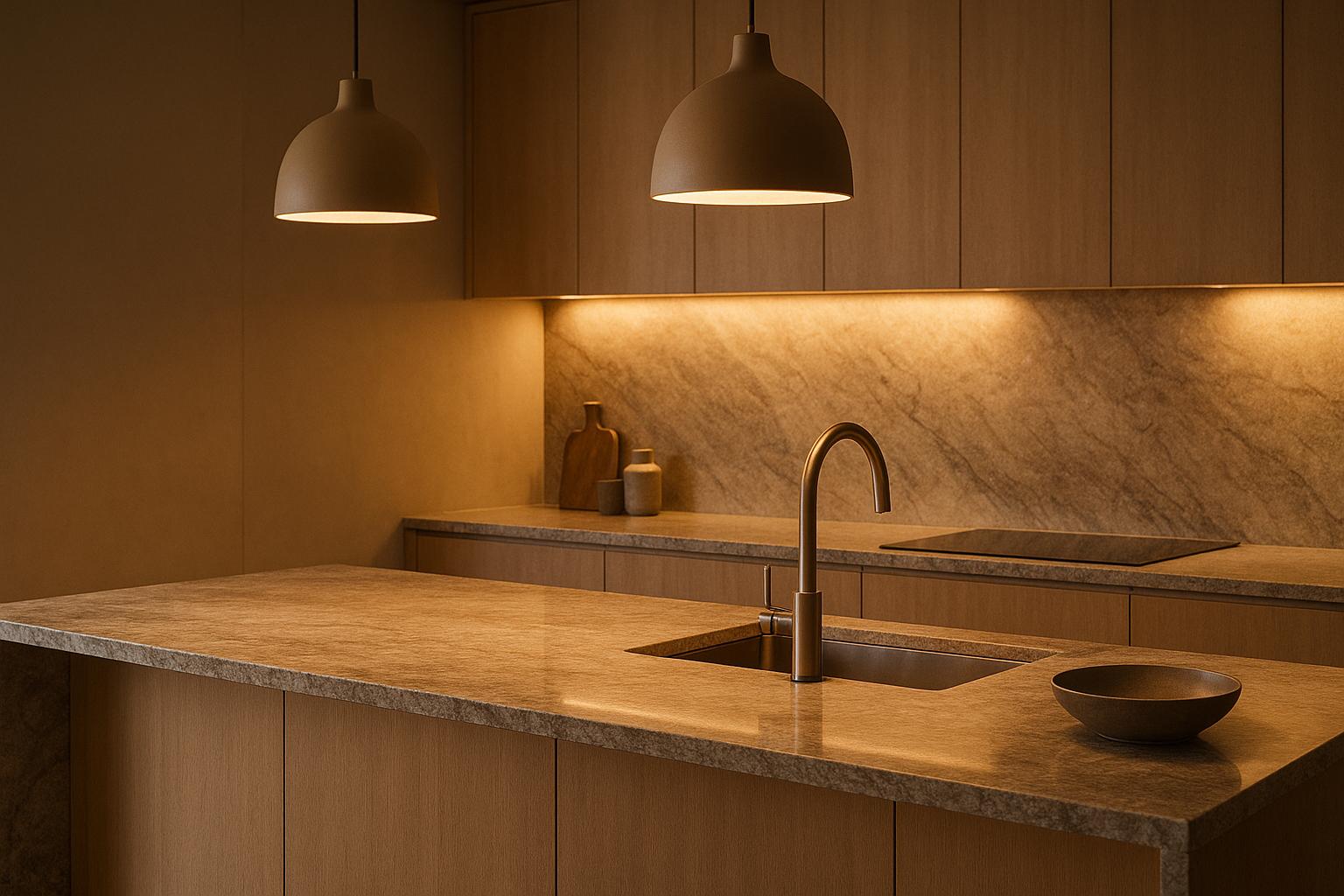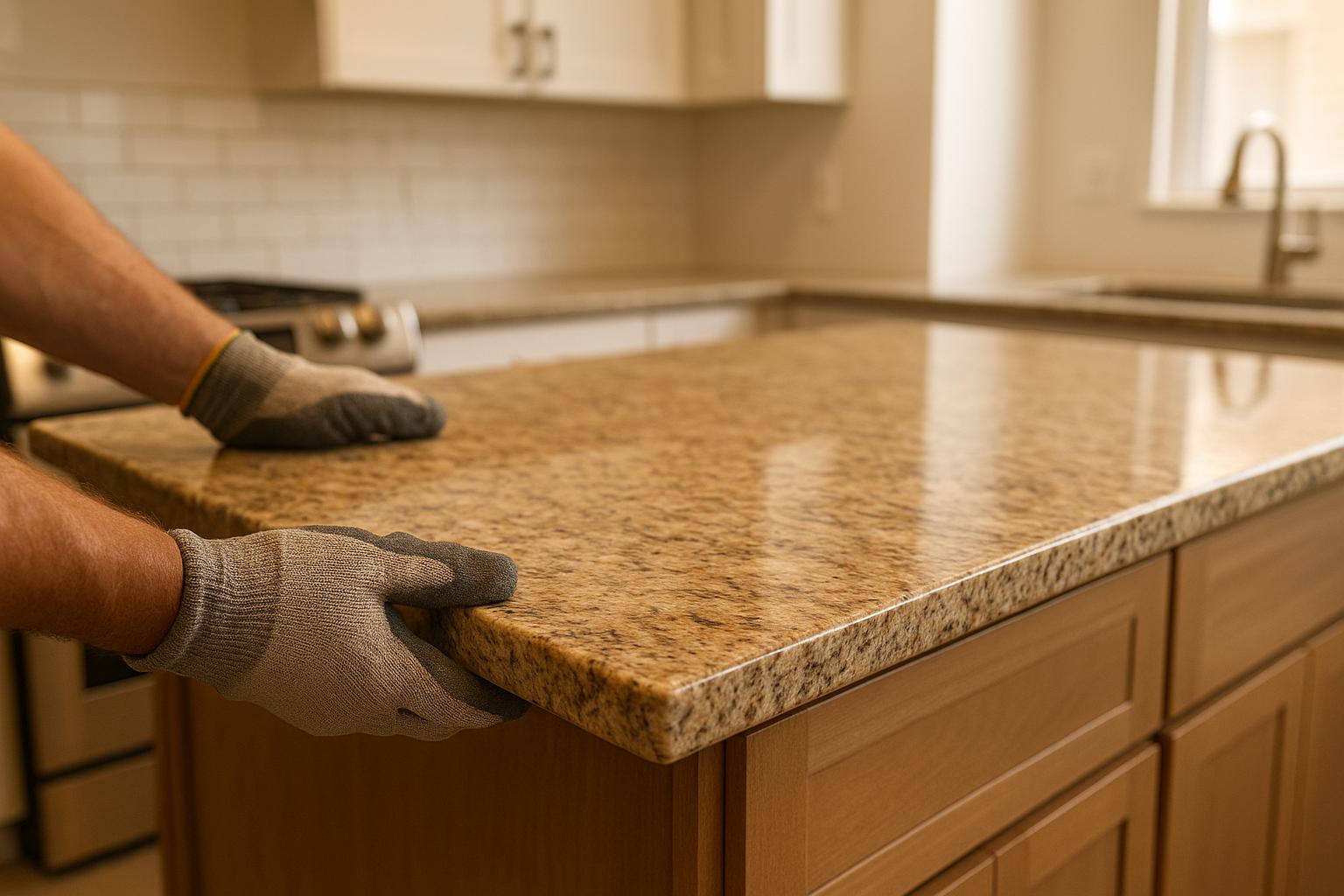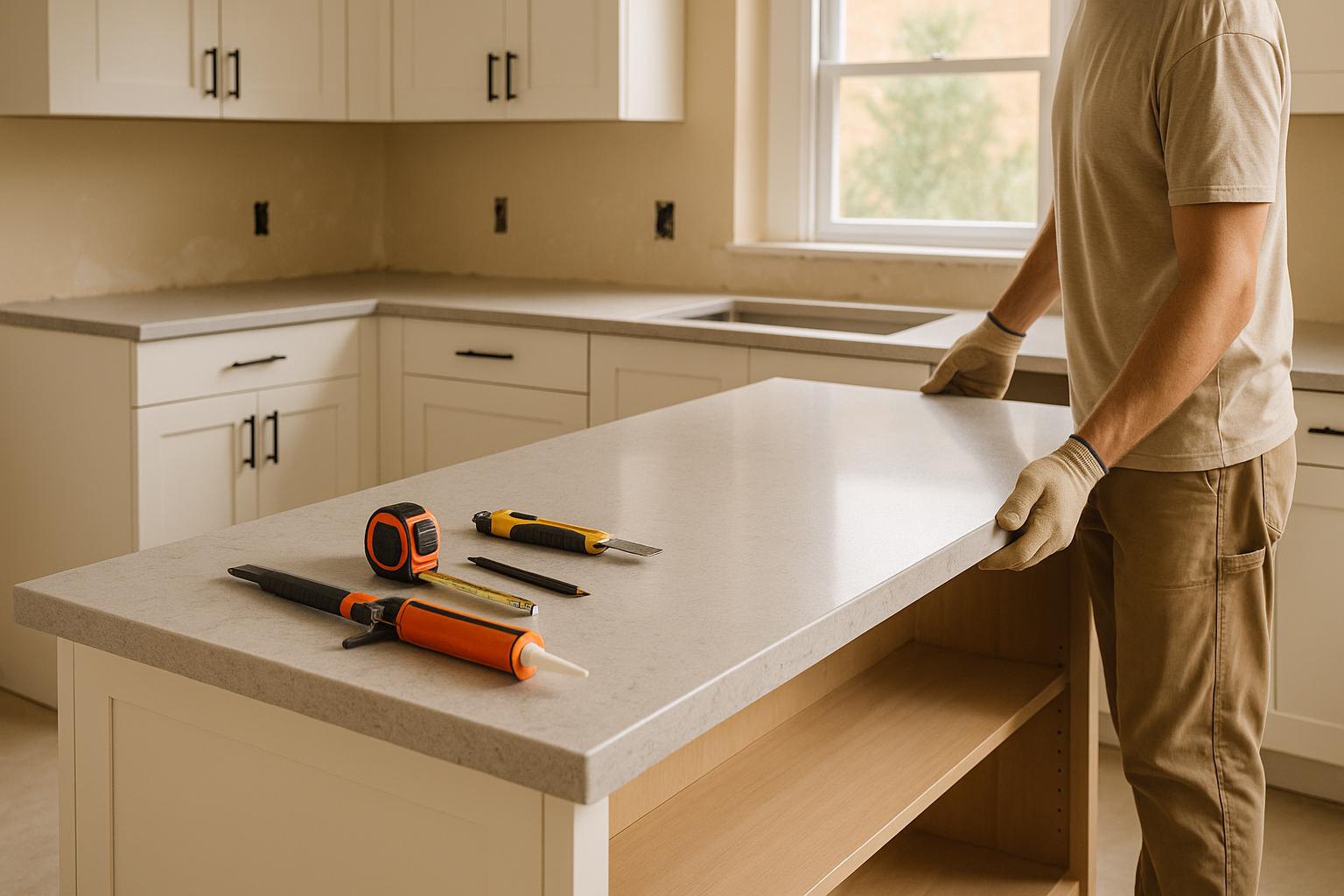Stone countertops can lose their visual appeal and functionality without the right lighting. Poor placement leads to shadows, glare, and uneven brightness, making tasks harder and dulling the stone’s natural beauty. Here’s how to fix these issues:
- Common Problems: Shadows from cabinets, glare on polished surfaces, and poor task lighting.
- Solutions:
- Use under-cabinet lights to brighten workspaces.
- Hang pendant lights 30–36 inches above islands for even coverage.
- Position recessed lights 18–24 inches from walls for balanced illumination.
- Tailored Lighting:
- Light-colored stones need warm, moderate lighting.
- Dark stones benefit from brighter, diffused setups.
- Accent lighting highlights veined or textured stones.
- Natural Light: Skylights and windows can enhance stone textures and colors.
Proper lighting transforms your kitchen into a functional and inviting space. For best results, consult professionals for precise placement and integration.
How I Backlit Quartzite Countertops / The Wiring / What I Used / LED RGBW Crystallo Sunset
Lighting Problems in Stone Countertop Kitchens
Stone countertops, while undeniably elegant, come with some challenges that can affect both their practicality and visual appeal.
Shadows from Fixtures and Cabinets
Shadows are a common issue in kitchens with stone countertops, often caused by poor lighting placement and cabinetry design. Recessed lights that aren’t positioned carefully can cast harsh shadows across work areas. Upper cabinets also block light, creating dark zones behind the countertops. To make matters worse, the overhanging edges of stone surfaces add another layer of shadowing on the countertop itself. These shadowy areas can make tasks like chopping vegetables or measuring ingredients much harder to do accurately.
Glare on Polished Stone Surfaces
Polished stone surfaces like granite, marble, or quartz can reflect overhead lighting in a way that’s more distracting than helpful. The glare from these reflections can make it hard to focus on the work surface and takes away from the natural beauty of the stone’s unique patterns and colors. This reflective quality often creates bright, uncomfortable spots that strain the eyes, especially during detailed tasks like food preparation.
Poor Task Lighting in Work Areas
Insufficient lighting in food prep areas is more than an inconvenience – it’s a safety risk, especially when combined with the shadowing effects of stone countertops. The natural tones of stone can make it harder to spot small items like utensils, spills, or food scraps, which means focused lighting is essential. Adding targeted lighting can brighten these shadowed areas, making the space not only safer but also more vibrant and functional. Without proper lighting, even the most stunning stone countertops can fall short in terms of usability and safety. Addressing these issues is key to creating a well-lit, practical kitchen space.
How to Fix Lighting Placement Issues
Lighting placement can make or break the functionality and appeal of your kitchen, especially when working with stone countertops. By strategically positioning fixtures, you can tackle common problems like shadows, glare, and uneven illumination, ensuring your kitchen is both practical and visually stunning.
Pendant Lights for Kitchen Islands
Pendant lights are a great way to reduce shadows and brighten up kitchen islands, especially when recessed fixtures are placed too far back. To get the best results, hang your pendant lights 30–36 inches above the countertop. This height provides enough task lighting without creating harsh glare. If your kitchen island is over 6 feet long, consider using multiple pendants spaced evenly across the surface to maintain consistent light coverage.
Under-Cabinet Lighting Installation
Under-cabinet lighting is a game-changer for eliminating shadows cast by upper cabinets. It creates bright, focused light on your countertops, which is essential for tasks like chopping and prepping food. LED strips are a popular choice for this because they’re energy-efficient, long-lasting, and produce a soft, welcoming glow. For polished stone surfaces, using high-density LED strips with frosted diffuser covers can help avoid the reflection of individual LED dots, creating a smoother, more uniform light.
"I don’t like LED strip lights, the individual LEDs and the strip effect bounces off the polished stone and looks cheap and cheesy. Individual fixtures ‘wash’ the counter top." – jehovahs_waitress, r/HomeImprovement
To optimize placement, mount under-cabinet lights about 1 inch from the cabinet’s front edge to minimize shadowing. When it comes to installation, you have two main options: plug-in fixtures or direct wire fixtures. Plug-in options are easier for DIY projects since they don’t require electrical work, while direct wire fixtures offer a cleaner, cord-free look.
Recessed Lighting for Even Coverage
Recessed lighting is ideal for general kitchen illumination, but placement is critical to avoid unwanted shadows around your stone countertops. To achieve balanced lighting, position recessed lights 18–24 inches from the wall, directly in front of your cabinets. Space the fixtures 4 to 6 feet apart, adjusting as needed based on ceiling height and the beam angle of your bulbs.
If you want to highlight specific features of your stone countertops, such as the bold veining in marble or unique granite patterns, adjustable or gimbal recessed lights are a smart choice. These fixtures let you direct the light exactly where you want it, enhancing the natural beauty of the stone.
Making the Most of Natural Light
Natural light can bring out the best in stone countertops, showcasing their true colors and intricate patterns. Adding windows, skylights, or light-colored window treatments can amplify this effect. North-facing windows provide steady, even light throughout the day, while south-facing windows bring in bright illumination that enhances lighter stone shades. If your kitchen lacks natural light, a skylight above the island or main prep area can brighten the space and reduce shadows, offering a more accurate view of your stone surfaces.
sbb-itb-e397dd0
Lighting Tips for Different Stone Types
The way each stone interacts with light can dramatically affect its appearance and functionality. By tailoring your lighting choices to the specific stone, you can enhance its natural beauty and make your space more practical. Here’s how to light different types of stone effectively.
Lighting for Light-Colored Stones
Stones like white quartz and Carrara marble reflect light beautifully, creating a bright and open feel. Because these stones naturally amplify light, moderate lighting works best to avoid overwhelming the space.
Warm white LEDs (around 3000K) are ideal for these stones, adding a cozy glow without making the room feel too stark. Recessed lighting can provide even coverage, but be mindful of fixture placement to minimize harsh shadows.
For added flexibility, dimmable lights are a smart option. They let you brighten the room when preparing meals and create a softer, more inviting atmosphere for dining or hosting guests. This balance keeps the space well-lit while preserving the stone’s soft tones.
Lighting for Dark or Glossy Stones
Dark stones, like black granite or soapstone, absorb more light and need brighter illumination to ensure proper visibility. However, glossy or polished finishes can reflect light in ways that cause glare if the lighting is too direct.
To avoid this, opt for diffused lighting, such as frosted under-cabinet LED strips, which spread light evenly without harsh reflections. A layered lighting plan works well here – combine under-cabinet lights, recessed fixtures, and pendant lights over islands to create balanced illumination. This approach softens contrasts between bright and shadowed areas, making the space more visually pleasing.
Accent Lighting for Veined or Textured Stones
Veined, patterned, or textured stones can become stunning focal points with the right accent lighting. Adjustable track lights or gimbal recessed fixtures are great for highlighting intricate patterns. For translucent stones like onyx, backlighting can make the material glow, creating a striking visual effect.
The color temperature of your lighting also plays a role. Warm lighting (2700K–3000K) enhances golden or warmer tones in the stone, while cooler lighting (3500K–4000K) brings out grays and subtler hues. Experimenting with different temperatures can help you find the perfect match for your stone’s unique characteristics.
For textured surfaces like honed granite or brushed marble, wall washing – where light grazes the surface at a low angle – can accentuate the texture while still providing functional lighting for tasks. This technique adds depth and dimension to the stone, making it stand out beautifully in your design.
Coordinating Lighting with Kitchen Layout and Renovations
When designing your kitchen lighting, it’s important to think about how it interacts with your cabinet layout, appliance placement, and overall kitchen flow. This becomes especially critical during renovations, where thoughtful coordination can enhance both functionality and style. Proper lighting design not only improves visibility but also highlights the beauty of your stone surfaces.
Matching Lighting with Cabinets and Appliances
Your cabinets and appliances play a big role in how light is distributed throughout the kitchen. For example, under-cabinet lighting is often necessary to prevent shadows on countertops, especially in areas where tall appliances might block overhead light. Cabinet finishes also matter – light-colored cabinets bounce light around the room, while darker finishes may require brighter or additional fixtures to achieve the same effect. Paying attention to these details ensures that your lighting complements your kitchen’s layout and design.
MI Stone’s Complete Kitchen Renovation Services

Lighting coordination becomes much easier when you work with a team that handles multiple aspects of your renovation. MI Stone offers a fully integrated approach, managing countertops, cabinetry, and lighting together. This ensures everything – from electrical work to final fixture placement – works in harmony.
For example, their team plans electrical rough-ins alongside cabinet installation and countertop templating. This means under-cabinet lighting aligns perfectly with your countertops, and pendant lights are chosen to enhance both your cabinetry and stone selection. Importantly, electrical work is done early in the process, but fixture placement is finalized only after you’ve selected your countertop material. Different stones – like light quartz, dark granite, or veined marble – interact with light in unique ways, and MI Stone’s expertise ensures your lighting enhances the specific material you choose.
Why Professional Measurements and Templates Matter
Accurate measurements and custom templates are essential for more than just fitting your countertop – they also guide lighting placement. Templates identify workspace dimensions, irregularities, and seam locations, all of which influence where lighting should go. For instance, accent lighting can highlight or downplay seams, depending on your design preferences.
Proper installation is equally important. Countertop edges need to align perfectly with cabinet faces to ensure that under-cabinet lighting hits the work surface evenly. Even minor misalignments can create shadows or uneven lighting. MI Stone’s precise templating and installation process ensures everything fits together seamlessly, avoiding these issues.
For the best results, consider having your lighting contractor review the stone templates before finalizing fixture placement. This step can save you from costly adjustments later and guarantees a polished, cohesive finish for your kitchen.
Conclusion: Better Lighting for Your Stone Countertop Kitchen
Good lighting doesn’t just make your stone countertop kitchen look stunning – it also makes it more practical and enjoyable to use. The right lighting setup can completely transform your kitchen into a lively, efficient, and inviting space.
Key Points to Remember
Tackle Common Lighting Issues
Use under-cabinet and recessed lights to reduce shadows and evenly brighten your space. These options also help cut down on glare, especially on polished countertop surfaces.
Layer Your Lighting
Mix and match different lighting styles: pendants for focused tasks, recessed fixtures for general illumination, and accent lights to bring out the texture and patterns in your stone countertops.
Tailor Lighting to Your Stone
Lighter stones, like white quartz, benefit from moderate lighting, while darker stones need brighter setups to stand out. Be mindful of placement to reduce glare and showcase the natural beauty of the stone.
Blend Lighting with Your Kitchen Design
Coordinate your lighting with the layout of your cabinets and appliances to create a seamless and functional design.
A thoughtful lighting plan doesn’t just highlight your countertops – it enhances your entire kitchen experience.
When to Call in the Pros
While these tips can guide you toward a solid lighting strategy, professional input can make all the difference. Expert lighting design and installation are essential for bringing out the best in your stone countertops during a kitchen renovation. MI Stone’s comprehensive approach ensures that your lighting, cabinetry, and countertops work together seamlessly. Their expertise helps you avoid costly mistakes and delivers a polished, harmonious finish that enhances both the style and functionality of your kitchen.
FAQs
How can I avoid shadows on my stone countertops with better lighting placement?
To minimize shadows on your stone countertops, focus on using task lighting or recessed lighting placed directly above your workspace. Aim the lights toward the center of the countertops, positioning them about 3 feet from the wall. This setup helps create even lighting and reduces shadows caused by overhead cabinets or your movements.
For added brightness, install under-cabinet lighting. This not only improves visibility but also enhances the look of your stone surfaces by showcasing the intricate patterns and textures of materials like quartz, granite, or marble. Thoughtful lighting placement can make a big difference in both functionality and aesthetics.
What are the best lighting options to enhance the beauty of stone countertops in a kitchen?
To bring out the stunning patterns and textures of stone countertops, thoughtful lighting choices make all the difference. Here are a few effective options to consider:
- Under-cabinet LED strip lighting: These lights shine directly onto the countertop, showcasing the intricate details and natural variations in materials like quartz or granite.
- Pendant lights: Hanging pendant lights with a warm glow can enhance the depth and elegance of surfaces like marble, while also creating a cozy and inviting atmosphere.
- Directional recessed or track lighting: Adjustable fixtures let you highlight specific areas, drawing attention to the unique textures and colors of the stone.
For a polished and harmonious effect, combine these lighting techniques with soft ambient lighting. This helps minimize harsh shadows while maintaining a unified and welcoming vibe. Smart lighting choices not only improve your kitchen’s functionality but also spotlight the timeless beauty of your stone countertops.
How do the color and finish of my stone countertop impact the lighting choices for my kitchen?
The color and finish of your stone countertop can make a big difference when it comes to choosing the best lighting for your kitchen. If you have polished surfaces like glossy granite or marble, these tend to reflect a lot of light. Pairing them with brighter, cooler lighting can really bring out their natural patterns and vibrant colors. On the flip side, countertops with matte or honed finishes absorb light, giving a softer appearance. Warm lighting works better here, as it enhances the subtle textures and tones of these finishes.
While natural light does a great job of showing off the true beauty of your countertop, it changes throughout the day. That’s why it’s important to pick artificial lighting that complements the unique features of your stone. Whether your countertop is quartz, granite, or marble, the right lighting can elevate both its look and practicality.



